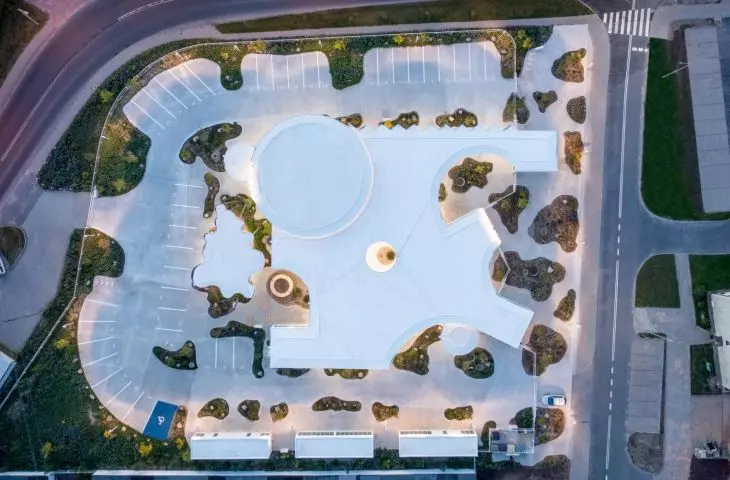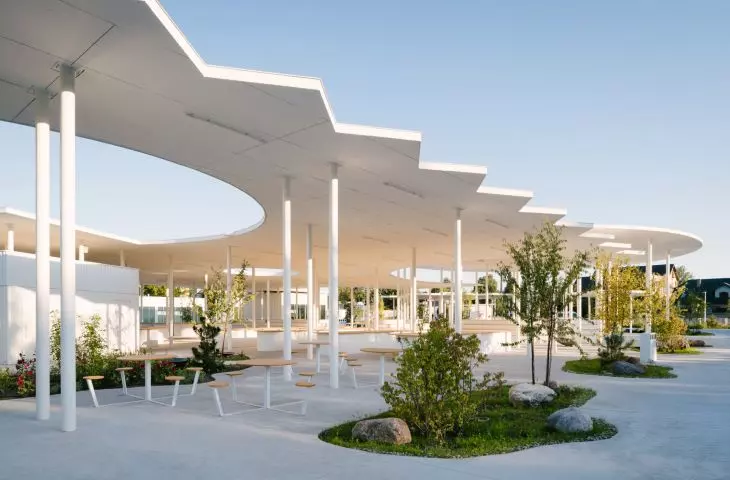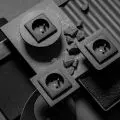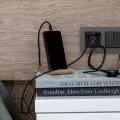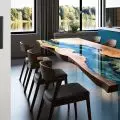Has the end of "high tone" architecture arrived? The twilight of iconic edifices and contemporary palaces? A time to look at the space around us from the perspective of those with various human and non-human users' needs? About - in the opinion of some - hitherto shameful architecture, frivolous forms and nature, which is sometimes worth simply leaving alone, we talk to Aleksandra Wasilkowska, author of the modernization of the Błonie Market near Warsaw.
As Aleksandra Wasilkowska points out, this bazaar feeds not only people, but also fauna and funga
Photo: Nate Cook
Ola Kloc: In an interview published in A&B in June 2021, you said "Bazaars are the most democratic space and are not necessarily for consumption only. They have a huge turnout, are popular, egalitarian and inclusive, open to everyone. That's why I think they should be designed like museums, theaters, like contemporary social palaces." We are talking today about the modernization of the Blonie Market - what was the design process like in this case? Did you have to convince anyone of your vision for the bazaars? To the fact that it's worth designing them with as much attention as buildings that are urban icons?
Aleksandra Wasilkowska: Of course, the palace is just a metaphor, I don't miss the monarchy [laughs]. What I meant was that bazaars or public toilets, everything that serves everyday life, deserves just as good architecture as important representative public buildings. The author of "Sitopia" [Carolyn Steel - editor's note], talks about how food is something that is shared by all social classes, and where we buy or produce food shapes our cities, our health and our environment. Bazaars make fresh, cheap and healthy food from farmers and local producers more accessible to everyone, hence the importance of good design of market spaces and good management of them. Bazaars are not only about fairer and healthier food for all, but also about supporting local entrepreneurship, shortening supply chains, and creating neighborhood places. Hence the importance for me of architecture related to small trade, something I call shadow architecture, that is, what previously seemed shameful, mediocre, inconvenient, but widely used. I would like to see bazaars return to the centers of cities and towns. The market should not be pushed to the periphery, but become a central space.
Błonie market
photo: Nate Cook
I've been involved with bazaars for twenty years, that is, since working on my diploma and the market on Parade Square. Along the way I've written several books on the subject. While twenty years ago bazaars were being dismantled en masse, I've been seeing a renaissance in them for some time now, bazaars especially during the pandemic have proved remarkably vital. As for the difficulties you ask about, I must admit that it was difficult for me to convince councilors and merchants to combine the bazaar with the park. The merchants were not thrilled with the amount of greenery and trees, and had concerns that the bushes would take away their parking spaces. Anyway, we are familiar with this discussion from many other developments, in which restoration or intensive greenery appears in place of parking spaces. Fortunately, I had tremendous support from the mayor and the director of the Public Utilities Department, who led this investment. Without them and the excellent contractors and the many people involved, this project would not have been so green and cohesive.
Błonie is a hybrid of park, square and bazaar
Photo credit: Nate Cook
Ola: There has been this post-pandemic shift to buying locally, to meeting others in public spaces. The market in Blonie is a place for people - it's not just a space for commerce, but it's intended to be a place for people to meet and hang out (a playground, a bar with a big table); by the way, Tomasz Malkowski in hits and kits named the market the best public space of last year! What do you think is the most important thing in building neighborhood spaces? What do we need to spend time together? How does the Market in Blonie respond to these needs?
Alexandra: Some bazaars operate seven days a week, others only three, especially those where the farmers themselves sell as in the case of the Blonie Market. Farmers must have time to work and grow their fruits and vegetables, and often come to the market only two or three times a week to sell their crops. On other days such a market is empty. And hence the idea that while the bazaar is closed, the same space could function as a public space, a park, a children's play garden, perhaps as a meeting place for skateboarders or rollerbladers, for whom I specially designed a smooth surface without divisions.
The swales overflow water into rain bowls, and later into rain gardens and greenery
photo: Nate Cook
I hope that in time this space will grow into the social life of the town and will be spontaneously used by people of all ages, will begin to live its life, not just a market. It's important to me to think of buildings and spaces as hybrids that can accommodate several functions at once and operate 24 hours a day, seven days a week. The Błonie Market is a hybrid of park, plaza and bazaar, in order to maximize this investment, the raw materials and the work that went into building it, for the largest possible group of residents.
The Błonie Market is a hybrid of park, square and bazaar
Photo credit: Nate Cook
Ola: Five hundred trees have been added to the area, in addition to taking care of a variety of vegetation, areas providing shelter for birds and rain gardens. What additional challenges are involved in implementing such solutions? What are their advantages?
Alexandra: Time will tell how plants, people, animals and their paths will intertwine in this place. The process of natural succession, which is the clou of this project, will cause some plants to outgrow or even displace other species. Maybe plants appear that we didn't plant there, but their seeds were already in the soil like goldenrod or nettles, which I like very much. This process is natural, and it's best when humans don't specifically interfere with it. So I hope that in time this place will become a naturalistic, slightly wild park. The big challenge was the rain and the drainage of water from the large canopy, which I totally wanted to retain on site. Several pukes overflow the water into rain bowls and later into rain gardens and greenery. With heavy rainfall, it gets very wet for a while, which is great for plants and animals and the microclimate, but not necessarily for merchants. Fourth nature, wildlife, ruderal plants, diverse tree species, when subject to natural succession and not specially cared for, are cheaper to maintain, hardy and beautiful. Tree logs and branches left behind create food for many insects and fungi. Fruit trees give food to birds. So this bazaar feeds not only people, but also fauna and fungus.
Rain bowls; tree logs and branches left behind create food for many insects and fungi
photo: Nate Cook
Ola: The whole thing is covered by a canopy with an irregular shape - what is the reason for this shape? Why did you opt for white?
Alexandra: White roofs are a passive cooler, their degree of reflection of the sun's rays is the greatest, so it is easier to prevent heat islands. I think black felt roofs will slowly disappear from the cityscape. White reflects the sun well, creates a bright space and positively inspires. There is a reason why Greece is white, and for that reason white was modernism. As for the form of the roof itself, this is a very important part of the project for me. The roof of the market is the fifth elevation that is seen from the windows of nearby houses, so it must be beautiful. Differences in the roof appear in the faults and openings to light the merchants' displays. A more frivolous organic form of the roof distinguishes the children's play garden. Thus, the roof's cleavage is a combination of an analysis of the wandering of light and water, but also a thoughtful formal composition.
The Błonie Market, the roof is the fifth elevation as seen from the windows of the buildings surrounding the market
Photo: Nate Cook
Ola: Thank you for the interview.






